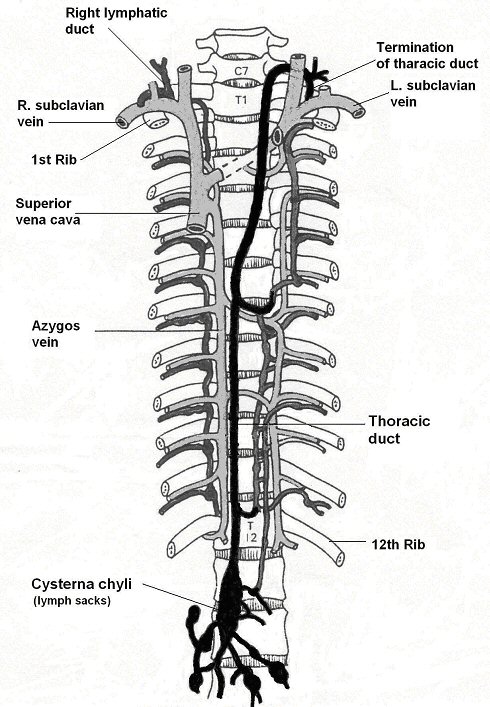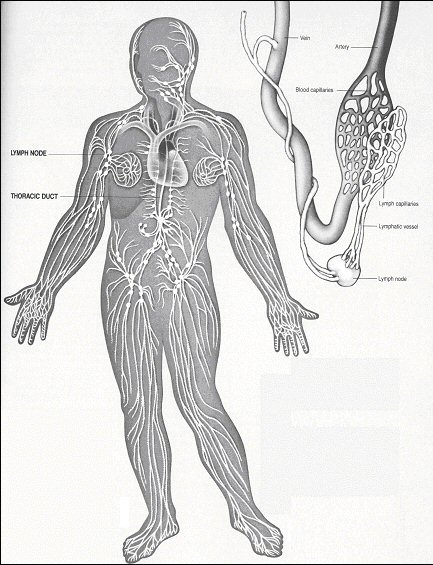By Andreas Moritz
Gallstones in the liver may lead to poor circulation, enlargement of the heart and spleen, varicose veins, congested lymph vessels and hormone imbalance. When gallstones have grown large enough to seriously distort the structural framework of the lobules (units) of the liver, blood flow through the liver becomes increasingly difficult. This not only raises the venous blood pressure in the liver, but also in all of the organs and areas of the body that drain used blood through their respective veins into the portal vein of the liver. Restricted blood flow in the portal vein of the liver causes congestion, particularly in the spleen, stomach, distal end of the esophagus, pancreas, gallbladder, and small and large intestines. This can lead to enlargement of these organs, reduce their ability to remove cellular waste products and clog their respective veins.
A varicose vein is one that is so dilated that the valves do not sufficiently close to prevent blood from flowing backward. Sustained pressure on the veins at the junction of the rectum and anus in the large intestine leads to the development of hemorrhoids. Other common sites of varicose veins are the legs, the esophagus and the scrotum. Dilation of veins and venules (small veins) can occur anywhere in the body. It always indicates an obstruction of blood flow. (See Note 1 at the end of this article.)
Poor blood flow through the liver also affects the heart. When the organs of the digestive system become weakened by an increase in venous pressure, they become congested and begin to accumulate toxic waste, including debris from cells that have been broken down. The spleen becomes enlarged while it is dealing with the extra workload associated with removing damaged or worn-out blood cells. This further slows blood circulation to and from the organs of the digestive system, which stresses the heart, raises blood pressure and injures blood vessels. The right half of the heart, which receives venous blood via the inferior vena cava from the liver and all other parts below the lungs, becomes overloaded with toxic, sometimes infectious material. This eventually causes enlargement of the right part of the heart.
Almost all types of heart disease have one thing in common: there is an obstruction of blood flow. However, blood circulation does not become disrupted easily. It must be preceded by a major congestion of the bile ducts in the liver. Gallstones obstructing the bile ducts dramatically reduce or cut off the blood supply to the liver cells. Reduced blood flow through the liver affects the blood flow in the entire body which, in turn, has a detrimental effect on the lymphatic system.
The lymphatic system, which is closely linked with the immune system, helps to clear the body of harmful metabolic waste products, foreign material and cell debris. All cells release metabolic waste products into, and take up nutrients from, a surrounding solution, called extracellular fluid or connective tissue. The degree of nourishment and efficiency of the cells depends on how swiftly and completely waste material is removed from the extracellular fluid. Since most waste products cannot pass directly into the blood for excretion, they accumulate in the extracellular fluid until they are removed and detoxified by the lymphatic system. The potentially harmful material is filtered and neutralized by lymph nodes that are strategically located throughout the body. One of the key functions of the lymphatic system is keeping the extracellular fluid clear of toxic substances, which makes this a system of utmost importance.
Poor circulation of blood in the body causes an overload of foreign, harmful waste matter in the extracellular tissues and, consequently, in the lymph vessels and lymph nodes. When lymph drainage slows down or becomes obstructed, the thymus gland, tonsils and spleen start to deteriorate quickly. These organs form an important part of the body’s system of purification and immunity. In addition, microbes harbored in gallstones can be a constant source of recurring infection in the body, which may render the lymphatic and immune systems ineffective against more serious infections, such as infectious mononucleosis, measles, typhoid fever, tuberculosis, syphilis, etc.
Due to restricted bile flow in the liver and gallbladder, the small intestine is restricted in its capacity to digest food properly. This permits substantial amounts of waste matter and poisonous substances, such as cadaverines and putrescines (break-down products of fermented and putrefied food), to seep into the lymph channels. These toxins, along with fats and proteins, enter the body’s largest lymph vessel, called thoracic duct, at the cysterna chyli. The cysterna chyli is a lymph-dilation (in the shape of sacks), situated in front of the first two lumbar vertebrae (see Figure 1).
Toxins, antigens and undigested proteins from animal sources, including fish, meat, eggs and dairy food, cause these lymph sacks to swell and become inflamed. When cells of an animal become damaged or die, which happens seconds after it is killed, their protein structures are broken down by cellular enzymes. These so-called ‘degenerate’ proteins are useless for the body, and they become harmful unless they are promptly removed by the lymphatic system. Their presence usually invites enhanced microbial activity. Viruses, fungi and bacteria feed on the pooled wastes. In some cases, allergic reactions occur.
When there is lymph sac congestion, the body’s own degenerate cell proteins can no longer be removed properly. The result is lymph edema. While lying on the back, existing lymph edemas can be felt as hard knots, sometimes as large as a fist, in the area of the navel. These ‘rocks’ are a major cause of middle and low back pain and abdominal swelling, and, in fact, of most symptoms of ill health. Many people who have grown a ‘tummy’ consider this abdominal extension to be just a harmless nuisance or a natural part of aging. They don’t realize that they are breeding a living ‘time bomb’ that may go off some day and injure vital parts of the body.
Eighty percent of the lymphatic system is associated with the intestines, making this area of the body the largest center of immune activity. This is no coincidence. The part of the body where most disease-causing agents are combated or generated is, in fact, the intestinal tract. Any lymph edemas, or other kind of obstruction in this important part of the lymphatic system, can lead to potentially serious complications elsewhere in the body.

Figure 1: Cysterna chyli and thoracic duct
Wherever a lymph duct is obstructed, there is also an accumulation of lymph at a distance to the obstruction. Consequently, the lymph nodes located in such an area can no longer adequately neutralize or detoxify the following things: dead and live phagocytes and their ingested microbes, worn-out tissue cells, cells damaged by disease, products of fermentation, pesticides in food, inhaled or congested toxic particles, cells from malignant tumors, and the millions of cancer cells every healthy person generates each day. Incomplete destruction of these things can cause these lymph nodes to become inflamed, enlarged and congested with blood. Infected material may enter the blood stream, causing septic poisoning and acute illnesses. In most cases, though, the lymph blockage occurs slowly, without any symptoms other than swelling of the abdomen, hands, arms, feet, or ankles, or puffiness in the face and eyes. This is often referred to as ‘water retention,’ a precursor of chronic illness.
Continuous lymphatic obstruction usually leads to chronic conditions. Almost every chronic illness results from congestion in the cysterna chyli. Eventually, the thoracic duct, which drains the cysterna chyli, gets overburdened by the constant influx of toxic material and becomes clogged up, too. The thoracic duct is linked up with numerous other lymph ducts (see Figures 1 and 2) that empty their waste into the thoracic ‘sewage canal.’ Since the thoracic duct has to remove 85% of the body’s daily generated cellular waste and other toxic material, a blockage there causes back-flushing of waste into other, more distant parts of the body.
When the daily-generated metabolic waste and cellular debris are not removed from an area in the body for a certain period of time, symptoms of disease start manifesting. The following are but a few typical examples of illness indicators that result directly from chronic, localized lymph congestion:
Obesity, cysts in the uterus or ovaries, enlargement of the prostate gland, rheumatism in the joints, enlargement of the left half of the heart, congestive heart failure, congested bronchi and lungs, enlargement of the neck area, stiffness in the neck and shoulders, backaches, headaches, migraines, dizziness, vertigo, ringing in the ears, earaches, deafness, dandruff, frequent colds, sinusitis, hay fever, certain types of asthma, thyroid enlargement, eye diseases, poor vision, swelling in the breasts, breast cancer, kidney problems, lower back pains, swelling of the legs and ankles, scoliosis, brain disorders, memory loss, stomach trouble, enlarged spleen, irritable bowel syndrome, hernia, polyps in the colon, etc., etc.
The thoracic duct empties its contents into the left subclavian vein at the root of the neck. This vein enters the superior vena cava, which leads straight into the left side of the heart. In addition to blocking proper lymph drainage from these various organs or parts of the body, congestion in the cysterna chyli and thoracic duct permits toxic materials to be passed into the heart and heart arteries. This unduly stresses the heart. It also allows these toxins and disease-causing agents to enter the general circulation and spread to other parts of the body. There rarely is a disease that is not caused by lymphatic obstruction. Lymph blockage, in most cases, has its origin in a congested liver (the causes of gallstones in the liver are discussed in detail in The Amazing Liver and Gallbladder Flush). In the extreme eventuality, lymphoma or cancer of the lymph may result, of which Hodgkin’s disease is the most common type.
When the circulatory system begins to malfunction as a result of gallstones in the liver, the endocrine system also becomes affected. The endocrine glands produce hormones that pass directly from the glandular cells into the blood stream, where they influence bodily activity, growth and nutrition. The glands most often affected by congestion are the thyroid, parathyroid, adrenal cortex, ovaries, and testes. A more severely disrupted circulatory function leads to imbalanced hormone secretions by the Islets of Langerhans in the pancreas, and the pineal and pituitary glands.

Figure 2: Lymphatic system and lymph node
Blood congestion, which is characterized by thickening of the blood, prevents hormones from reaching their target places in the body in sufficient amounts and on time. Consequently, the glands go into hyper-secretion (overproduction) of hormones. When lymph drainage from the glands is inefficient, the glands, themselves, become congested. This brings about hypo-secretion (lack) of hormones. Diseases related to imbalances of the thyroid glands include toxic goiter, graves disease, cretinism, myxoedema, tumors of the thyroid, hypo-parathyroidism, which reduces calcium absorption and causes cataracts, as well as behavioral disorders and dementia. Poor calcium absorption, alone, is responsible for numerous diseases, including osteoporosis (loss of bone density). If circulatory problems disrupt secretion of balanced amounts of insulin in the pancreatic islets of Langerhans, diabetes results.
Gallstones in the liver can force the liver cells to cut down protein synthesis. Reduced protein synthesis, in turn, prompts the adrenal glands to overproduce cortisol, a hormone that stimulates protein synthesis. Too much cortisol in the blood gives rise to atrophy of lymphoid tissue and a depressed immune response, which is considered to be the leading cause of cancer and many other major illnesses. An imbalance in the secretion of adrenal hormones can cause a wide variety of disorders as it leads to weakened febrile response and diminished protein synthesis. Proteins are the major building blocks for tissue cells, hormones, etc. The liver is capable of producing many different hormones. Hormones determine how well the body grows and heals.
The liver also inhibits certain hormones, including insulin, glucagon, cortisol, aldosterone, thyroid and sex hormones. Gallstones in the liver impair this vital function, which may increase hormone concentrations in the blood. Hormone imbalance is a very serious condition and can easily occur when gallstones in the liver have disrupted major circulatory pathways that are also hormonal pathways.
Disease is naturally absent when blood and lymph flow is unhindered and normal. Both types of problems, circulatory and lymphatic, can be successfully eliminated through a series of liver cleanses and prevented by following a balanced diet and lifestyle.
Note 1:
Prescribed by doctors in Germany as a highly successful alternative to surgery for varicose veins, the herbal remedy horse chestnut seed, or conkers, is very effective in the treatment of heavy legs, hemorrhoids and cramps. In combination with cleansing of the liver, colon, and kidneys, conkers can lead to complete recovery.
You may share or republish this article provided you clearly mention the name of Andreas Moritz and paste a hyper link back to the post.





